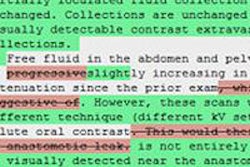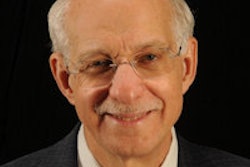
Just as healthcare reform is increasing the need for new skills to be incorporated into graduate medical education (GME) curricula, Medicare budget cuts threaten to undercut the federal support that covers most of the cost of medical residencies, according to a new article in the Journal of the American College of Radiology.
Future Medicare cuts, widely anticipated as part of ongoing deficit reduction efforts in the coming years, will almost certainly lead to reductions in the number of radiology residency positions, the authors assert. Over time, major cuts could lead to staffing shortfalls in academic radiology departments at a time when healthcare reform is placing new demands on residency training, according to the research team from Brown University. The serious cuts haven't happened yet, however. Are they even a realistic possibility?
"I think the GME cuts are going to be very real; our institution, since we wrote [the JACR article], has started to cut positions," said Dr. Martha Mainiero in an interview with AuntMinnie.com. "I think it's going to be very institution-specific, which programs and how much is cut. And the point of the article is that a lot of people have no idea what's going on."
Dire effects?
The effects of healthcare reform on resident education could be dire, both in terms of staffing and morale. With less resident involvement in daily service and less money coming into hospitals to support graduate medical education, "it will be a challenge to maintain faculty members' time and interest in teaching the next generation of radiologists," wrote Mainiero and her colleague Dr. Robert Ward from Brown's Alpert Medical School (JACR, May 13, 2013).
 Dr. Martha Mainiero from Brown University.
Dr. Martha Mainiero from Brown University.
Federal subsidies, administered through the U.S. Centers for Medicare and Medicaid Services (CMS), have long funded graduate medical education in the U.S. In 2010, for example, the government provided $9.5 billion in GME funding and an additional $2 billion in matched dollars in subsidies.
But budget shortfalls, rising healthcare costs, and a sluggish economy have focused attention on cutting GME spending, they wrote. While cuts are considered, healthcare reform is placing new demands on residency training.
"Radiology programs have particular vulnerability and challenges associated with GME funding cuts and healthcare reform expectations," Ward and Mainiero wrote. "For radiology to be as well-positioned as possible in this new era of declining funding and healthcare reform, we must demonstrate that we add quality and value, by first defining best practices in the discipline under the new drivers for healthcare and then adopting, modeling, and teaching these practices to our trainees."
Obamacare and deficit reduction
Medicare spending cuts have been on the table since long before Obamacare arrived on the scene, of course, but it's the confluence of forces in healthcare reform that is causing hospitals to fret about income and turn to an intense focus on cost-cutting, according to Mainiero.
It's been almost 20 years since the days when hospitals could get more residents pretty much whenever they needed them, she said. As a result, "many of us have had increasing volume over the years without increasing the number of residents, so we've already learned a little bit" about getting along with less. But deeper cuts would go further, forcing institutions to think not only about changing work patterns, but also about changing the ways they educate residents.
"It's not new to Obamacare that GME is being looked at as a potential place to save money," Mainiero said. "It's just that everything is coming to a head with healthcare spending. I think the reason that it ties together with Obamacare is that the hospitals who employ the physicians feel that with everything changing for them, they are seeing less money coming in. So the urgency to reduce healthcare expenditures within hospital systems has [increased] with Obamacare."
The cost of GME
Graduate medical education is expensive, with approximately 115,000 doctors currently in U.S. residency programs, and federal support contributes about $100,000 per year to each one, the team wrote. State and local funding bring total public expenditures to $500,000 or more over the course of one doctor's training.
Of the approximate $9.5 billion spent on GME in 2010, $3 billion contributed to direct medical education (DME), which directly funds residencies, while $6.5 billion was allocated to indirect medical education (IME), which is calculated as a percentage add-on to an institution's residency costs that varies based on teaching intensity (i.e., the number of residencies compared to the number of beds).
But the high cost, especially of IME, is being increasingly challenged, the authors wrote. Among the challengers is the Medicare Payment Advisory Commission (MedPAC), which in 2010 stated that only 40% to 45% of IME payments can be analytically justified to cover the higher patient-care costs of Medicare inpatients. MedPAC concluded that at least half of the payments cannot be justified. Such a move would effectively lower the IME add-on percentage from 5.5% to 2.2%, trimming $3.5 billion from the budget.
In December 2010, the Simpson-Bowles commission, appointed by Congress to find ways to cut the federal deficit, recommended capping IME payments at 120% of the national average paid to residents that year. The group recommended that all of the money saved by cutting IME payments in half should go toward deficit reduction rather than returned to the Medicare trust fund for incentive payments.
The cut would effectively cap resident compensation at $45,000 to $50,000 per year, with disproportionate effects on residents in areas burdened with high costs of living, Ward and Mainiero wrote.
Hoping to fend off program-wrecking cuts, the Association of American Medical Colleges (AAMC) and the Accreditation Council for Graduate Medical Education (ACGME) have detailed the negative effects of GME payment cuts on medical training. An ACGME survey of institution officials estimated that a 50% cut in GME funding would cause 28% of programs to close, while a 33% reduction would cause 18% of programs to close, according to the article.
"Subsequent to the ACGME survey, President Obama's plan for economic growth and deficit reduction was released in September 2011, which called for a reduction in IME adjustments by 10%, from 5.5% to 4.95%, beginning in fiscal year 2013," the authors wrote. The projected savings would total nearly $10 billion over the next 10 years.
The U.S. budget process, now apparently stalled in Congress for the summer, is expected to begin in earnest this fall, when the U.S. debt ceiling will likely need to be raised as part of any spending plan, compelling the nation's two warring political parties to negotiate a deal.
Funding cuts conflict with healthcare needs
Even without cuts, there are concerns that doctors will be in short supply as tens of millions of new patients become insured under the Patient Protection and Affordable Care Act (PPACA), the authors wrote. They cited a predicted shortfall of 63,000 U.S. physicians by 2015 and 130,000 by 2025, according to the AAMC.
When GME funding is cut, "decisions about whether to decrease resident salaries, decrease resident positions, or cut entire programs are typically at the discretion of the institution," Ward and Mainiero wrote. They also cited the case of St. Barnabas Hospital in New York City, whose radiology residency program is slated for termination, with the federal funds being shifted to primary care in anticipation of PPACA.
In terms of day-to-day staffing, facilities may need to get creative, employing physician assistants and in some cases radiology assistants for tasks such as simple interventional procedures and primary interpretation.
"A decrease in resident numbers, or a decline in funding, may result in faculty members' having fewer resources to devote to traditional one-on-one, apprentice-style teaching and daily educational conferences that have been the bedrock of radiology residency education," Ward and Mainiero wrote.
Departments should seek alternative sources of funding from other government agencies, including the U.S. Department of Veterans Affairs, the U.S. Public Health Service, the U.S. Department of Defense, or even foreign governments. They should also investigate states (Medicaid) and nongovernmental entities such as industry, philanthropic organizations, and faculty practice plans, they wrote.
Stakeholders are currently studying options, according to the authors. The Josiah Macy Jr. Foundation has awarded $750,000 to the U.S. Institute of Medicine for its report on medical imaging; two public meetings have been held to date, and the final report will be issued in 2014.
It's up to radiologists, residents, and departments to demonstrate the value of what they are doing and make the case for continued funding, according to Mainiero.
"I think if they don't try to make the case, they're really going to have a problem," she said. "And I think more than ever you have to show that your service, which includes the work your residents are doing, is vital to the hospital and is improving the quality of care in the hospital. The more you can show those things, the better position you're going to be in when it's time to make the cut."



















